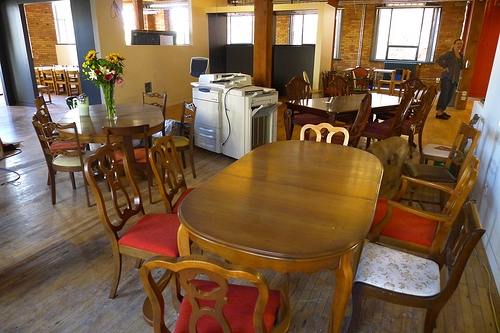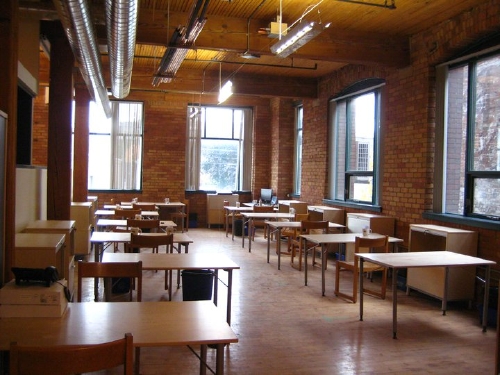We know that change is needed, that our current systems can’t last forever, and that we need to re-examine and re-evaluate how we go about everything from energy production to granting mortgages. But we don’t often know, practically, what change looks like – we know what isn’t working, but not necessarily how to make change happen.
But sometimes we can find our way out of the Gordian knot by bringing together existing ideas to dream up a new tool to get us out of the bind. In fact, the best innovation comes squarely out of need.
At the Centre for Social Innovation we are dedicated, in our very existence, to change. By providing shared workspaces, incubating emerging enterprises, and developing new models and methods with world changing potential, we have a commitment to change built into our DNA.
Recently at CSI, we confronted a challenge of our own. For six years we’d been operating out of UrbanSpace’s amazing Robertson Building, a brick-walled old warehouse, beautifully restored and complete with green wall and rooftop patio. CSI leases space on two floors, and sublets to our members. It has worked brilliantly, but when a beautiful building at Bathurst and Bloor came on the market, we thought it would make an incredible 2nd location. But how does a small nonprofit organization, lacking a single asset, raise $6.5m to finance and develop a building?
We were not alone. In the world of small, community-minded organizations – everyone from local nonprofits to arts organizations to recreation centres – one of the biggest perennial challenges is financing. In a climate of shrinking government budgets, drying up pools of grant money, and a still-fragile economy, these organizations find themselves in ever more precarious situations. Stability is hard to come by, and growth can become difficult to even contemplate.
What we needed, and what so many other organizations need also, is a change in the available financing mechanisms – an innovative strategy that would open up new alternatives for us, a creative way we could pay for the expansion. We needed a way of jumping from having no assets to owning a building. Not an easy jump.
And so, after some great conversations with both lawyers and business advisors, we pulled a bunch of different ideas together to create a “community bond” – a clever way of unleashing the potential of a regular RRSP investor (you and me) to be able to “invest locally.”
Community bonds are loans that offer both a social and financial return on investment, and enable communities to leverage their constituents’ financial resources to create the spaces and programs that will enable them to thrive.
Held by members of our own community – tenants new and old, board members, foundations, and members of our community – these bonds are available with a minimum investment of $10,000, are RRSP-eligible, and will be repaid on a 5-year schedule, at a 4% return. In today’s market, they are a solid investment for anyone interested in supporting their local economy.
Unlike the bonds issued by large companies, however, ours have a blended benefit: they reap not just financial but social rewards as well. By fostering the expansion of CSI and providing space for a host of new member organizations, the bonds increase our collective social and entrepreneurial capital, increase collaboration in the city and will be another launch pad for social innovators and innovations.
As I mentioned, we didn’t have a single asset when we went to go buy this building, but what we did have was our incredible network of relationships. Community bonds enabled us to create value by leveraging those relationships in pursuit of a common goal.
The Centre for Social Innovation is still selling community bonds to fulfill our dreams, but we are also enamoured with the potential of community bonds to bring back a DIY culture to co-create community assets in our neighbourhoods.
Community bonds are a tool with tremendous potential for what we call the “citizen sector” – the people and organizations who take action to serve others – because they empower communities to create their own solutions. Just imagine a theatre company banding its audiences together to refurbish its stage, or a recreation centre using a bond to build a new skating rink with a solar panelled roof, repaying investors with income from ice-time rentals and solar power, and creating young athletes and renewable energy at the same time. Imagine the flourishing and vibrant communities with a community-based financing model to make it happen.
Tools for change. A social innovation is behaviour-changing, systems-changing and solves a real problem for community benefit. Community bonds represent a newer, more humane, more collaborative kind of capitalism, one in which we pool our resources for the common good as well as shared gain. Just one element in a growing toolset, community bonds offer a new approach to an old challenge, and provide a new mechanism that can enable us to invest in the projects that are important to us at a local level.
For more information about community bonds and the work of the Centre for Social Innovation check out www.socialinnovation.ca.
Tonya Surman is the founding executive director of the Centre for Social Innovation. She has been creating and leading social ventures since 1987 and has built her body of knowledge around multi-sectoral collaboration and entrepreneurship for social change. She currently co-chairs the Ontario Nonprofit Network and the Social Enterprise Council of Canada.




